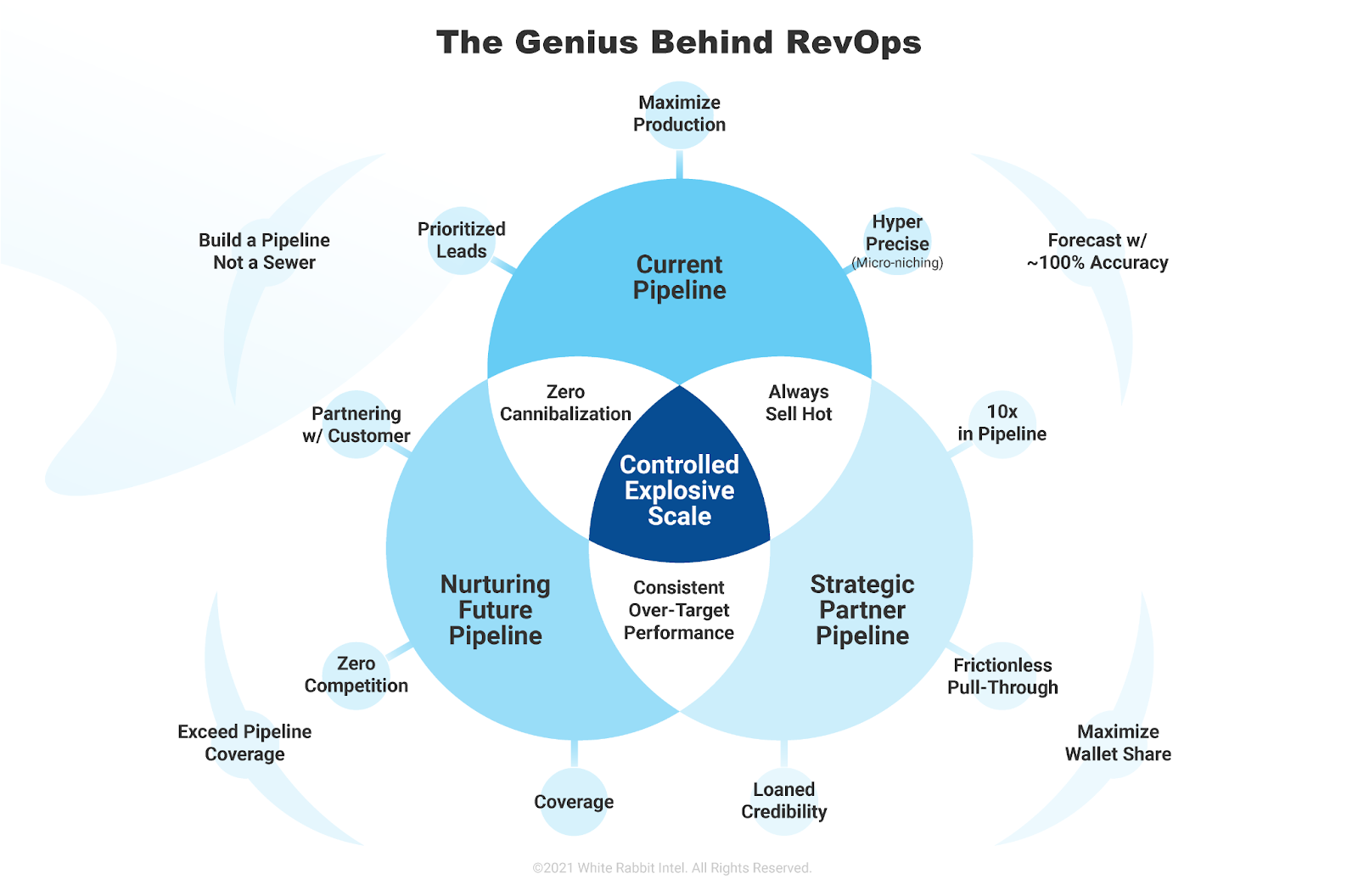11.4 minutes
Destroy your silos before your silos destroy you
For decades, the self-destructive situation nearly every business has been recklessly neglecting is publicly rearing its ugly head—the siloing of marketing, sales, and customer success as separate functions. Most organizations will flat-out deny or are entirely ignorant that this is their reality. Failure to evolve beyond this “tradition” puts businesses in a state of serious risk if they don’t start acting now.
A slew of 24K gold-painted bandaids have been slapped onto this festering wound that “salve” the problem instead of “solve” it. We’ve been implementing decentralized strategies with specialized processes and roles to slay this beast called SalesOps, MarketOps, and ClientOps.
Hyper-specialized roles and strategies are essential, of course, though it’s lethal when we continue to integrate them into these silos within our businesses. Despite a tiny exception of a few, we all do it. There’s no denying it. Those few who have evolved beyond the status quo have implemented data-driven RevOps processes into the core of their organization’s revenue strategy.
Put your money where your customer’s mouth is
Think about the title of this section of the article for a few seconds. Soak it in.
Every business owner, C-Suite executive, or managing director would unanimously agree that it is imperative to understand your customer’s needs, pains, and desires while having the ability to speak to them in their language.
Speaking the customer’s language is rarely (often never) accomplished unless all three revenue-generating functions of a business are in tune with their clients and working in harmony.
Most businesses have not set up their systems to support data-driven behavior. Data-inept systems cannot enable a proper RevOps process to sustain a de-siloed centralized revenue initiative.
Data-driven RevOps is used to solve the customer language barrier
Sales Teams must record the real reason and pain, in detail, of why customers are buying the product in the customer’s words, not their own. “Because it was a good fit” is un-f*cking-acceptable. That data gets fed to the customer success team to properly prepare and learn what they need to help solve rather than hitting “reset” each pass-off. It enables the marketing team to know why the hell people buy; that aren’t the biased assumptions the team comes up with during a brainstorming session.
Success Teams must record result metrics, establish feedback loops, and mutual accountability, though most importantly, understand the customer’s needs. People buy experiences and outcomes—period. This data gets fed to the sales team to drive sales with hero’s journeys. It informs the marketing team to know what content to create that sustains the flow of value to strengthen relationships, fuel upsells/cross-sells to feed the sales team, and incentivizes repeat buyers to spend more.
Marketing Teams must record the movement of the marketplace, the engagement with the message they send, and create demand to feed the sales team with leads that convert. High-conversion marketing is driven by leveraging data the sales and success team provides [should be] to make educated, strategic decisions when building a marketing plan with a strategy revolving around facilitating the customer’s success, needs, and pains—spoken in their language.

What can be achieved is incredible when all three functions work together and enable each other rather than unknowingly disabling one another to better their independent processes.
This process is efficient and effective only when suitable data tracking protocols are in place, paired with a genuine, in-depth understanding of your Ideal Customer Profile (ICP).
Centralize focus around the customer to unify your silos
Centralization of the three functions promotes a lean, optimized, effective process. It creates a seamless, client-centric experience when meshed together. The customer language barrier is only one small piece of the puzzle that a proper data-driven RevOps process can solve.
How does this affect a business?
The magic behind data-driven RevOps
Implementing data-driven RevOps processes enables you to have a firm grasp on the “who”—meaning we can understand “who” buys from us, is loyal to us, and gives us the ability to speak using the customer’s words. To have the ability to know when the time is right for us to reach out.
For example, my own company and some clients we work with track the type of data necessary for this endeavor. We had dozens of assumptions about when we should reach out when it’s a “hot lead” and the million-dollar question. “What makes a marketing qualified lead “qualified?” Our assumptions were dead wrong.
We analyzed client data from CS and marketing data from visitors whose identities were resolved from web traffic. We were able to deliver our sales teams leads that are high priority. We found that clients who’ve had between 1-4 sessions on our site amounted to ~88% of our closed-won business. Doing the same AI analysis on CRM data across 19 different B2B industries resulted in a near-identical statistic, give or take a few points higher or lower.
“So what?”
It means that the marketing team should not send leads with a high site visit rate to their sales team. If they’ve visited over seven times, it’s a red flag. Misleading, isn’t it? High site visit rates are good for e-commerce, though in this case, it’s usually a false positive.
It means one of two things. A) they don’t understand the value prop, or B) like consuming your content but have no interest in doing business with you. You have better chances of securing new business with people who have a low site visit rate in a short period. It seems backward, doesn’t it? Though it is the truth.
We have used CS data to analyze the customers, sales data to analyze the lost business, and marketing data to identify the web traffic behaviors. We’ve leveraged all three functions supporting each other to find out the solution to one of the most elusive issues in business—opportunity identification. The magic of data-driven RevOps is impressive, no?
That is only one of the numerous solutions that utilize RevOps data analysis strategies to fill the needed shoes. Sewing up the fractured process where each of the three functions could not communicate and collaborate effectively and only from the data perspective. Imagine what can be done from a behavioral and operational point of view.
Over the last seven years, I’ve seen organizations evolve from a fragmented customer lifecycle that was individually defined by each customer-facing team to a comprehensive approach where teams collaborate throughout the sales, marketing, and CS funnel.
-Kate Gollogly, Director of CS, DocSend | Sales Hacker
Now take a moment to think about this
How the hell were we all convinced that it’s a no-brainer to target, market, and sell to tens of thousands, if not millions, of people who aren’t a fit and have no intent to buy whatsoever?
Survey says!
*Ding* “Awareness” — awareness to whom?
*Ding* “Visibility” — visible to whom?
*Ding* “It’s a numbers game” — and you believe this is true because…?
*Ding* “It’s the way it’s done” — so your status quo-itis is terminal?
Do you see the problem here?
We have failed to build our process around the customer. We don’t understand them. We have purposefully created blatant divisions that separate our teams. (We quite literally call them divisions!) That divide isn’t only an internal issue. It externalizes whether we like it or not.
It’s the beginning of a new era
Remember the saying, “if you try to please everyone, you please no one?” That applies directly to our issue. Try to market and sell to everyone; you end up converting no one. Cookie-cutter doesn’t exist.
Data-driven RevOps and AI hyper-targeting technology is the future that will be putting an end to the noisy high-volume era. Bulk selling, spray-and-pray marketing, and bulk ads hemorrhage our resources. We’ve been digging our graves, miles deep, though we can stop any time—we just have to put down the damn shovel first.
Hyper-targeting is a new concept that is finally hitting the market and gaining traction quickly. The magic behind this kind of tech/process combo can see through the veil of the “shiny object,” see where the real opportunities are, and weed out the false positives, as mentioned previously. Few people truly understand that marketing and selling is a removal process at its core, not an additive one.
We don’t need more leads. We need more best-fit opportunities, which in turn, are far less than we’d expect. Why do we keep buying haystacks when we’re actively looking for needles? Why not just buy a needlestack? This is what AI hyper-targeting technology brings to the table.
The answer to the ultimate question lies within
A question that’s near impossible and incredibly expensive to find the answer to without merging your silos into a client-centric unit.
If you take away anything about data-driven RevOps, let it be that it is crucial for revealing the answer to the ultimate question:
“How and why do we attract, acquire, and retain customers?”

